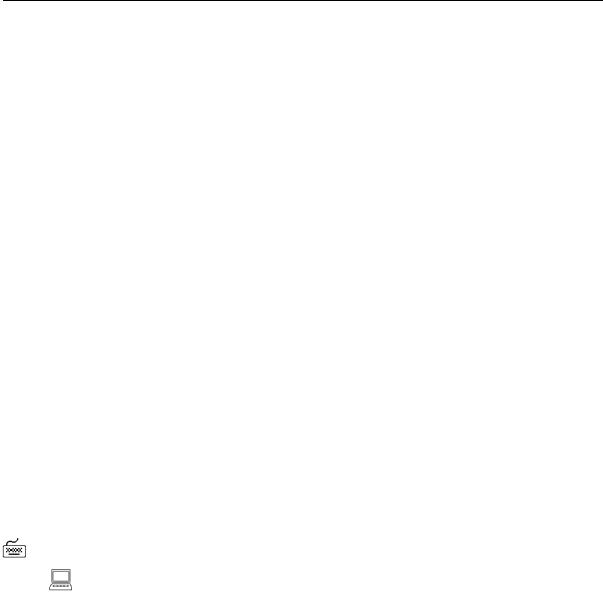
- •Contents
- •Send Us Your Comments
- •Preface
- •1 Introduction to iSQL*Plus
- •What is iSQL*Plus?
- •iSQL*Plus Architecture
- •iSQL*Plus User Interface
- •Oracle HTTP Server
- •Oracle9i
- •2 Configuring iSQL*Plus
- •System Requirements
- •Web Browser (client tier)
- •Oracle HTTP Server (middle tier)
- •Oracle9i (database tier)
- •Installation
- •Configuring the Client Tier
- •Adding MIME Types
- •Adding Proxy Server Exceptions
- •Configuring the Middle Tier
- •Configuring the iSQL*Plus Server
- •Defining a Connection Identifier
- •Setting the iSQL*Plus Session TimeOut
- •Changing the Default Cascading Style Sheet
- •Enabling or Disabling iSQL*Plus
- •Configuring the Oracle HTTP Server
- •Testing the Oracle HTTP Server Configuration File
- •Starting and Stopping the Oracle HTTP Server
- •Configuring the Database Tier
- •iSQL*Plus Security
- •Using Administration Privileges
- •Enabling User Security
- •Adding Entries to an Oracle HTTP Server Authentication File
- •Logging In Using Oracle HTTP Server Authentication
- •Security Usage Notes
- •Configuring Globalization Support
- •Web Browser - client tier:
- •Oracle HTTP Server - middle tier:
- •Oracle9i - database tier:
- •3 The iSQL*Plus User Interface
- •The iSQL*Plus Log In Screen
- •Help Icon
- •Username:
- •Password:
- •Connection Identifier:
- •Privilege:
- •Clear
- •The iSQL*Plus Work Screen
- •Password Icon
- •Log Out Icon
- •Help Icon
- •Enter statements:
- •Script location:
- •Browse...
- •Load Script
- •Execute:
- •Output:
- •Clear Screen
- •Save Script
- •The Change Password Screen
- •Help Icon
- •Username:
- •Old password:
- •New password:
- •Retype new password:
- •Change Password
- •Clear
- •Cancel
- •4 Using iSQL*Plus
- •Running iSQL*Plus
- •Entering Statements
- •Loading Scripts
- •Entering Substitution Variables
- •The Define Substitution Variables Screen
- •Password Icon
- •Log Out Icon
- •Help Icon
- •Define Substitution Variables
- •Submit for Execution
- •Cancel
- •Creating Dynamic Reports
- •Using SET and COLUMN Commands
- •Getting Help
- •Exiting iSQL*Plus
- •5 Command Reference
- •SQL*Plus Command Summary
- •@ (“at” sign)
- •@@ (double “at” sign)
- •/ (slash)
- •ARCHIVE LOG
- •ATTRIBUTE
- •BREAK
- •BTITLE
- •CLEAR
- •COLUMN
- •COMPUTE
- •CONNECT
- •COPY
- •DEFINE
- •DESCRIBE
- •DISCONNECT
- •EXECUTE
- •HELP
- •LIST
- •PROMPT
- •RECOVER
- •REMARK
- •REPFOOTER
- •REPHEADER
- •SHOW
- •SHUTDOWN
- •START
- •STARTUP
- •TIMING
- •TTITLE
- •UNDEFINE
- •VARIABLE
- •WHENEVER OSERROR
- •WHENEVER SQLERROR
- •SQL*Plus Error Messages and Codes
- •iSQL*Plus Error Messages
- •COPY Command Messages
- •PRODUCT_USER_PROFILE Table
- •Creating the PUP Table
- •PUP Table Structure
- •Description and Use of PUP Columns
- •PUP Table Administration
- •Disabling SQL*Plus, SQL, and PL/SQL Commands
- •Creating and Controlling Roles
- •Disabling SET ROLE
- •Disabling User Roles
- •Glossary
- •Index

SHOW
SHOW
Syntax
SHO[W] option
where option represents one of the following terms or clauses:
system_variable
ALL BTI[TLE]
ERR[ORS] [ { FUNCTION | PROCEDURE | PACKAGE | PACKAGE BODY | TRIGGER
| VIEW | TYPE | TYPE BODY | DIMENSION | JAVA CLASS } [schema.]name]
LNO
PARAMETERS [parameter_name] PNO
REL[EASE]
REPF[OOTER]
REPH[EADER] SGA
SPOO[L]
SQLCODE
TTI[TLE] USER
Shows the value of a SQL*Plus system variable or the current SQL*Plus environment.
Terms
Refer to the following list for a description of each term or clause:
system_variable
Represents any system variable set by the SET command.
ALL
Lists the settings of all SHOW options, except ERRORS and SGA, in alphabetical order.
BTI[TLE]
Shows the current BTITLE definition.
5-96 iSQL*Plus User’s Guide and Reference

SHOW
ERR[ORS] [{FUNCTION|PROCEDURE|PACKAGE|PACKAGE BODY|TRIGGER |VIEW|TYPE|TYPE BODY | DIMENSION | JAVA CLASS} [schema.]name]
Shows the compilation errors of a stored procedure (includes stored functions, procedures, and packages). After you use the CREATE command to create a stored procedure, a message is displayed if the stored procedure has any compilation errors. To see the errors, you use SHOW ERRORS.
When you specify SHOW ERRORS with no arguments, SQL*Plus shows compilation errors for the most recently created or altered stored procedure. When you specify the type (function, procedure, package, package body, trigger, view, type, type body, dimension, or java class) and the name of the PL/SQL stored procedure, SQL*Plus shows errors for that stored procedure. For more information on compilation errors, see your PL/SQL User’s Guide and Reference.
schema contains the named object. If you omit schema, SHOW ERRORS assumes the object is located in your current schema.
SHOW ERRORS output displays the line and column number of the error (LINE/COL) as well as the error itself (ERROR). LINE/COL and ERROR have default widths of 8 and 65, respectively. You can alter these widths using the COLUMN command.
LNO
Shows the current line number (the position in the current page of the display and/or spooled output).
PARAMETERS [parameter_name]
Displays the current values for one or more initialization parameters. You can use a string after the command to see a subset of parameters whose names include that string. For example, if you enter:
SHOW PARAMETERS COUNT
NAME |
TYPE |
VALUE |
------------------------------ |
----- |
----- |
db_file_multiblock_read_count |
integer |
12 |
spin_count |
integer |
0 |
The SHOW PARAMETERS command, without any string following the command, displays all initialization parameters.
Command Reference 5-97

SHOW
Your output may vary depending on the version and configuration of the Oracle database server to which you are connected. You need SELECT ON V_$PARAMETER object privileges to use the PARAMETERS clause, otherwise you will receive a message
ORA-00942: table or view does not exist
PNO
Shows the current page number.
REL[EASE]
Shows the release number of Oracle that SQL*Plus is accessing.
REPF[OOTER]
Shows the current REPFOOTER definition.
REPH[EADER]
Shows the current REPHEADER definition.
SPOO[L]
Shows whether output is being spooled.
SGA
Displays information about the current instance’s System Global Area. Note, you need SELECT ON V_$SGA object privileges to use the SGA clause, otherwise you will receive a message
ORA-00942: table or view does not exist
SQLCODE
Shows the value of SQL.SQLCODE (the SQL return code of the most recent operation).
TTI[TLE]
Shows the current TTITLE definition.
USER
Shows the username you are currently using to access SQL*Plus. If you connect as “/ AS SYSDBA”, then the SHOW USER command displays
USER is "SYS"
5-98 iSQL*Plus User’s Guide and Reference

SHOW
Examples
To list the current LINESIZE, enter
SHOW LINESIZE
If the current linesize is 80 characters, SQL*Plus will give the following response:
LINESIZE 80
The following example illustrates how to create a stored procedure and then show its compilation errors:
CONNECT SYSTEM/MANAGER CREATE PROCEDURE HR.PROC1 AS BEGIN
:P1 := 1; END;
/
Warning: Procedure created with compilation errors.
SHOW ERRORS
Errors for PROCEDURE HR.PROC1: LINE/COL ERROR
--------------------------------------------------------
3/1 PLS-00049: bad bind variable ’P1’ SHOW ERRORS PROCEDURE PROC1
NO ERRORS.
SHOW ERRORS PROCEDURE HR.PROC1 Errors for PROCEDURE HR.PROC1: LINE/COL ERROR
--------------------------------------------------------
3/3 PLS-00049: bad bind variable ’P1’
To show whether AUTORECOVERY is enabled, enter
SHOW AUTORECOVERY
AUTORECOVERY ON
To display the connect identifier for the default instance, enter
SHOW INSTANCE
INSTANCE "LOCAL"
Command Reference 5-99

SHOW
To display the location for archive logs, enter
SHOW LOGSOURCE
LOGSOURCE "/usr/oracle90/dbs/arch"
To display information about the SGA, enter
SHOW SGA |
|
|
Total System Global Area |
7629732 |
bytes |
Fixed Size |
60324 |
bytes |
Variable Size |
6627328 |
bytes |
Database Buffers |
409600 |
bytes |
Redo Buffers |
532480 |
bytes |
5-100 iSQL*Plus User’s Guide and Reference
